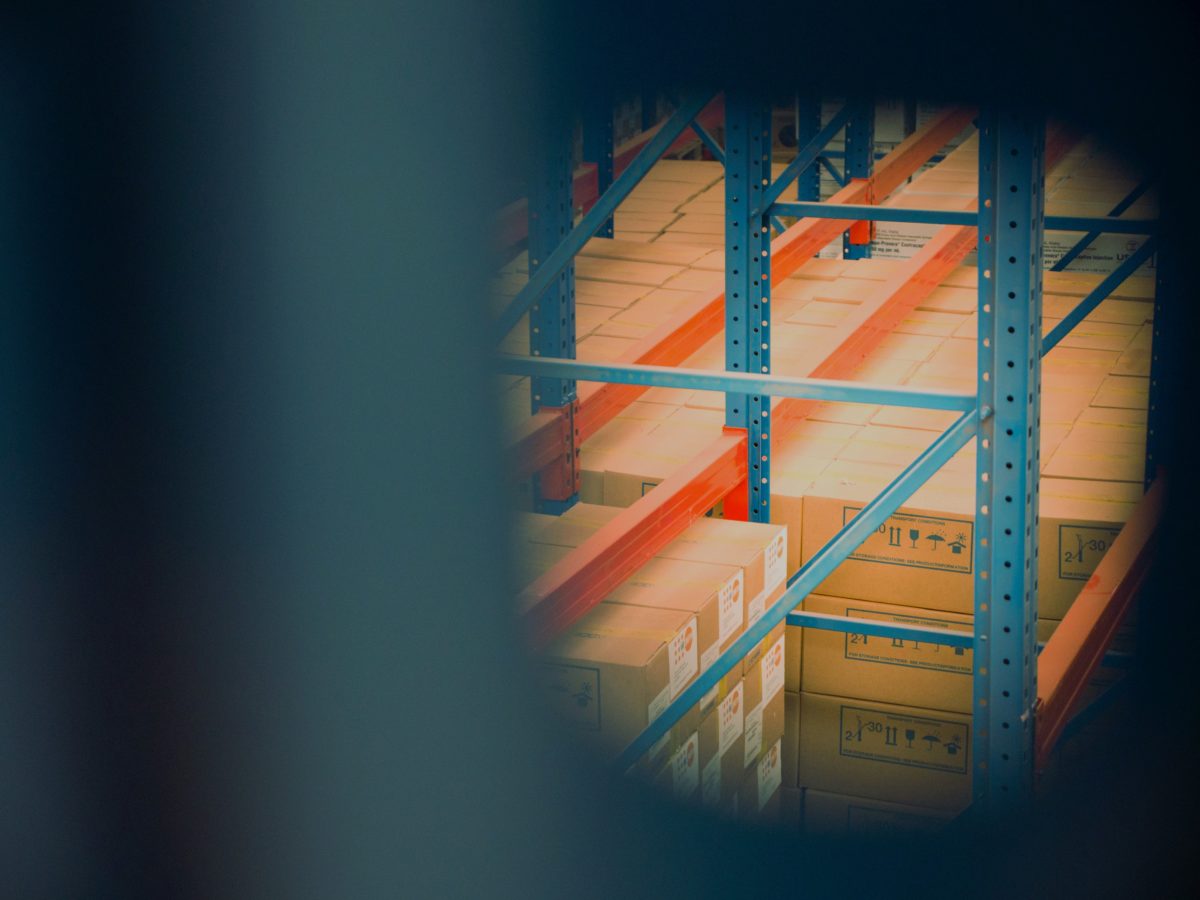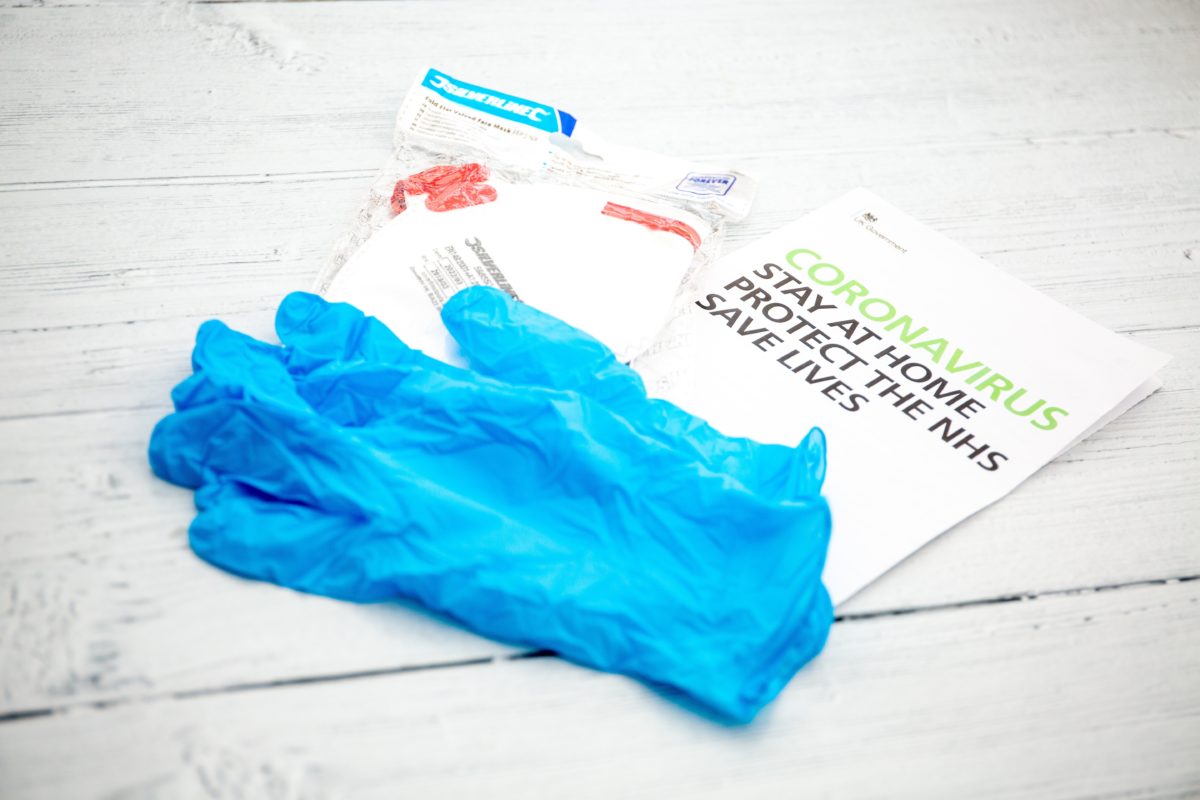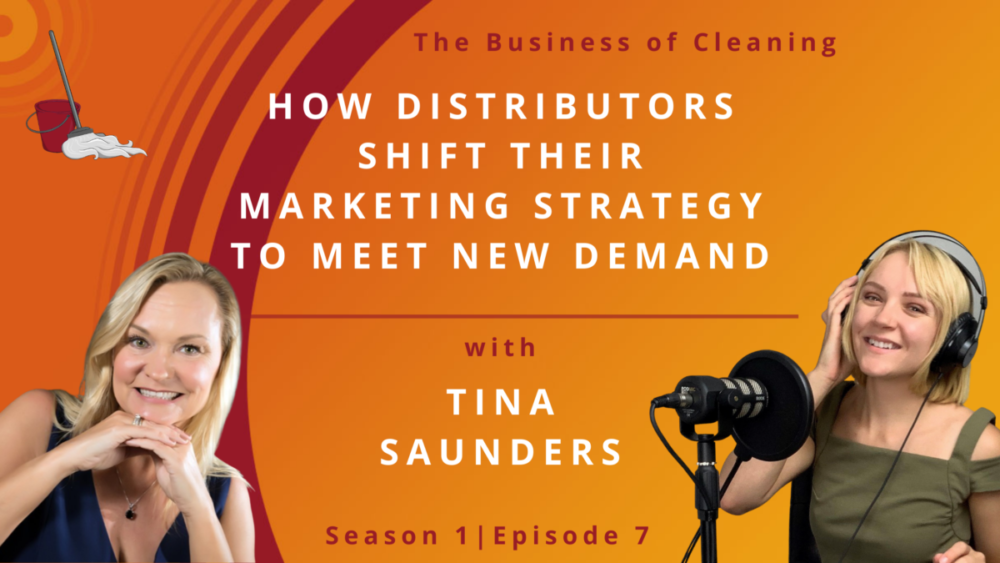It’s not just about increased demand as everyone shifts into the need of supplies during a pandemic. How exactly did distributors shift their strategy to meet the needs of their customers while shifting their marketing strategy?
Click Here To Subscribe On Your Favorite Platform!
About This Guest:

Tina Saunders
Director of Marketing and eCommerce - Nichols Paper
Tina Saunders is the Director of Marketing and eCommerce at Nichols Paper and Supply. The company has dealt with providing solutions to clean a healthy facility and the safe shipment of products. They’ve worked in many industries, most notably at the moment being businesses, health care, and schools.
Tina led the initiative to switch from product-centered marketing to education content and resources, focusing on quick and effective communication knowing that the demand would naturally be there and the supply would not quite meet it. We discussed the Better Together program that her team runs, how they educated and prepare schools, as well as the thought process behind the large shifts in strategy that they’ve made.

Podcast Transcription
Halie 0:00
Hello everyone and welcome to The Business of Cleaning podcast. My name is Halie Morris. I’m your podcast coordinator and host. Today with us, we have Tina Saunders from Nichols.
Tina is going to talk about how their company has pivoted during the pandemic, how they faced times of change and adjusted their marketing strategy accordingly. So Tina, if you wouldn’t mind, go ahead and introduce yourself and tell us more about Nichols.
Tina 0:56
Great. Thank you, Halie. I appreciate you having us on.
Nichols is a company that’s been in business since 1936. We are a provider of solutions for cleaning healthy facilities and a safe shipment of products. As you can imagine, in 2020, we’ve been really focused on clean and healthy facilities, especially as people are getting back to work.
So that’s Nichols. I am the Director of Marketing and e-commerce for the organization and we are a regional distributor. We’re in Michigan, Ohio, Indiana, and Illinois currently.
Halie 1:34
Oh, I see you got a pretty good stretch of customers then. Now, for your position, would you mind telling us a little bit more about what you do specifically?
Tina 1:44
So I manage the eCommerce platforms for Nichols, as well as the marketing team. That keeps me pretty busy. To bring Nichols, who has typically- I would say not typically, not since 1936, but in recent times has been pretty digital.
First, we’re pretty forward-thinking when it comes to using technology to help our customer’s journey. So making sure that our customers have an enjoyable and informative journey is my mission on the eCommerce side and then really the same thing as it parlays into the marketing message.
So helping our sales team to keep customers informed to stay up to date on the latest product innovations and the latest processes for cleaning and packaging, those are some of the things that my team stays busy with.
Halie 2:45
All right, thank you for that. Of course, with right now, with current times, we have a giant shift in what the world looks like. Not just here, but across the globe, it has changed. Before we get into what you guys have done specifically to pivot and adjust, do you mind talking to us about how you guys approached your marketing prior to COVID-19?
Tina 3:08
So prior to COVID-19, we were pretty- we vary our marketing based on the market segment that we’re speaking to. So we sell into education, whether it’s higher education or K thru 12. We sell into healthcare, both acute care hospitals, and long-term care facilities. We sell it to retail and grocery stores. We sell to them, not through them.
I’m missing some. Industrial is a big part of what we do. Food processing facilities, manufacturing plants, obviously, with the packaging side of our business. Helping them with a safe shipment of products really helps deliver the packaging and the efficient things like shrink wrap and stretch film and things like that.
So what we do from a marketing standpoint; We do, obviously, our websites. We’re pretty active on social media. We make sure that we’re blogging at least weekly to keep our customers informed as well as doing a lot of in-person events. Typically, over the summer to where we’re making sure that we have that interaction with our customer, that all of our key strategic suppliers have some face time with our best customers.
Then we typically enjoy a ballgame, a couple of beverages, and some dinner and barbecue, things like that with our customers. So wouldn’t that be fabulous? So we’d like to say thank you to our customers in that way. That was a challenge obviously, that we ran into this year.
Halie 4:46
Yeah, it’s an especially weird time. I know you were just listing it and I was like, “Oh my gosh, flashing back to better times.” Not this year, but we’ve done a company picnic so that in particular was a flashback.
So obviously, with such a large aspect of the customer appreciation and in-person type events, things couldn’t stay the same. I mean, we couldn’t even meet in offices unless you were considered an essential worker in March and for several months after.
So for you, then, where did you start to see your first shifts? Was it when we got the stay-at-home order? Was it prior to that?
Tina 5:29
So it was definitely a little bit prior to that. We saw it through the supply chain because many of our brands are global brands. So it really started hitting the global supply chain when it came to cleaning supplies, safety supplies. I think we saw it by mid to late January. Obviously the N-95 masks, we just couldn’t get them.
We’re like “what’s going on here?” Through the next three to four months that just steamrolled. Obviously, the pandemic hit every single- Well, I don’t know that every single country, but I assume- the majority of the countries on this planet.
So, the supply chain impact was the biggest impact on our customers, because the other thing, of course, is we promote products that we sell. When we couldn’t even get the products that we typically get, much less more of them to accommodate the drastically increased demand, that became a problem.
We can’t go on Facebook and say, “check out the latest Purell product”, if we don’t have the product to ship to the customer. So our entire messaging had to change away from the product.
Halie 6:57
So what did it change to now? What’s your focus since that shift up until now?
Tina 7:03
In March, I was actually on vacation the week that it was announced that it was a global pandemic. So that was interesting. I was glad to get home and then once I got home our marketing team’s focus was really to provide educational materials for our customers.
So, a lot of our vendors have done that and continue to do that every week. We get more and more white papers and signs and different things that we can offer our customers. But the first thing that we did was that we developed this program called #BetterTogether and it had all of the basics for posters.
I think we first introduced five posters that we posted on our public website. So not just for our customers, but for our communities. They could log in and download that poster for free. Then we printed and laminated some and sent them out to a lot of our better customers for things like washing your hands, maintaining social distancing, how to appropriately wash your hands, which is more steps then you might think there are.
Halie 8:17
For those listening, Tina is showing us one of the signs they actually have about how to properly wash your hands, which is so important right now.
Tina 8:28
Yeah, they can download it. I guess anybody with an internet connection can download all of those from our website. We initially rolled out five of those posters.
I’m going to say, within 10 days we had a new webpage section up dedicated to Better Together and to COVID-19 response. Better Together was one of the big things we did, making sure that our customers who utilize the equipment service knew how they could get ahold of their equipment service technicians, without having to come into the office or call the office number that maybe no one’s answering.
We, of course, we always had people answering the phones because we quickly deployed to home offices.
Then the other thing we did was we changed- one of the things that we sell a lot of every day even before COVID-19 is disinfectant. As you may know and many of your customers or listeners may know or may not, the EPA regulates disinfectants and states which disinfectants can be used for which pathogens. So, we took and we added the EPA registration number and the dwell time for this specific pathogen to our product detail pages on our eCommerce site.
Someone could go into our website within a few clicks, see every disinfectant that we have that has the EPA claim for the COVID-19 virus, the pathogen that causes the COVID-19 virus being the technically correct term.
Halie 10:21
I know everybody is just like, “oh my god! It’s just COVID-19.” So that’s a good point to put out with the pathogen. That’s technically what it is.
Tina 10:36
Yeah, like SARS-CoV-2 is the official name of the virus.
Halie 10:37
It’s so important right now with information because everybody’s running around with their heads cut off like chickens. “Oh, my gosh! What’s going on?” and you had a very quick response to that. On top of that, this wildness of what’s happening, we’ve never dealt with this, or we haven’t dealt with this for the last hundred years when influenza took out the beginning of the 20s.
That information was so mixed. People were so confused about the messages they were getting from the media and from social media, and cousins who are sharing things on Facebook and everything else.
So to have a reputable company, like yours come in and be like, here’s information directly from the companies that produce and the companies that handle this and have the education and the backing, and the understanding is so beneficial.
Tina 11:31
Exactly. That’s one of the things. We developed a lot of our own materials, which we have a lot of people that have been in the industry for a long time on our team. We also just relisted the materials that our suppliers gave us.
To be honest, there’s probably 25 different “how to wash your hands” posters available for download on our website. But hey, who are we to say which one you’d like the best. So we put them out there, and we share our industry resources from our suppliers and trust that one of those is going to find the sweet spot in each organization that logs in.
Halie 12:12
And it’s free! There are no excuses because they can go in and look at it and say, “Oh, my employees will listen to this,” and take out something that you’re already offering before you even establish a consumer-based relationship type deal.
Tina 12:33
Right. One of the reasons we even developed our own is just more of a branding type thing for us and for the customer. They may be using one brand of hand soap and another brand of hand sanitizer and a totally different disinfectant brand.
Then obviously, the masks come from a different manufacturer. Do you really want 17 different brands of posters hung throughout your facility? So by doing the Better Together program, we were able to create signage for everything they would need within their facility with a consistent look and feel.
Halie 13:09
Yeah, because we are people who are aesthetically-based. We like that proportionality of it’s all the same color or it all is the same formatting. It’s easier for people to understand when they’re looking at the same type of sign.

Tina 13:25
So that was really the biggest pivot we had to do. We went from product to purpose. We probably went five to six months without promoting products. I think we’re just now getting to the point that we’re starting to promote products again.
Halie 13:43
Well, and coming back to that, people think if you’re not promoting a product you’re not selling but that’s not necessarily true, is it?
Tina 13:51
No, not at all. People understand that cleaning is now not something those other people do. It’s a differentiating factor for customers and for companies right now.
If you’re not cleaning correctly, and if you’re not communicating that you’re cleaning correctly and making it clear to the people that enter your building, the guests that come into your facility, that you’ve taken the proper measures to make sure that they’re safe, they’re not going to come in.
So you know, it’s something that we’ve been calling the “Confidently Clean Facility”. “Cleaning Healthy Facilities” has been Nichol’s slogan for probably 15 – 20 years. Now it’s just more important than ever.
Halie 14:42
It goes back to this kind of natural shift we’re seeing with marketing as well. People want the relationship first before they buy from somebody. They want to value that connection ahead of time.
So I think we’ve just seen maybe a heavier emphasis on that it’s okay to sell products and promote products when it’s relevant, but people want to see that you’re sharing information, that you’re there for them, and not the other way around.
Tina 15:09
I think one of the other things with why we couldn’t promote the product was that we had such a backlog there. Every single manufacturer is putting their distributors on allocation. Basically, if it came to N-95 masks, certain PPE or personal protective equipment items, hand sanitizers, back when this first came out some hand soaps, disinfectants, those things were selling out globally.
We were literally like, “you can only buy exactly what you bought last year,” and it has to go to the same customers. So all of these new people that either couldn’t get it from their other distributor or have decided that they want to start disinfecting and washing their hands more often, you just couldn’t get it because of the global demand. The supply chain just was not geared up or anticipating that kind of demand.
We’re getting better, I will say. We still have back orders on some of the most popular pieces of equipment, on some of the traditional soaps and sanitizers that customers have been used to using, but a lot of the manufacturers have kind of streamlined operations.
They’ve said, “okay, we used to do 27 varieties of this. We’re only going to do five, but we’re going to do a lot of those five.” Now you’ve got to educate your customers on why they have to transition if we want to be sure of future allocations.
Halie 16:59
How do you communicate, though? You mentioned that you have to share that information with your customers? How do you establish that communication to where you’re not driving customers away, you’re just transitioning them over to a new way of doing things?
Tina 17:17
So originally we really changed what we were doing. Our communications with the e-blast and social media, and we did quarterly newsletters that had all the new products and things specific to each market segment. But they were very marketing messaged and what we wanted to do with the COVID-19 situation is make it more of business communication.
We took it from being this very splashy, rich content type of newsletter that we sent through our mass email system, to being an email from me to the customer, no photos, no splash, just very straightforward.
Here’s the situation with the supply and demand right now. Here’s the situation with how we’re going to handle customer deliveries. Here’s how we have to allocate healthcare and first responders first. It’s very much a business communication, as opposed to a marketing message.
Halie 18:31
It sounds like it would have come across a bit more personal. If it was coming for you and it’s coming just in a very basic format, “hey, they took the time to reach out to me directly.”
Tina 18:42
Yeah, we definitely wanted to have people understand that this is a personal important message for you to really understand what’s going on with the supply chain right now.
Halie 18:58
How have you seen what the response is to that message into how you’ve handled the situation? What’s the response from your customers?
Tina 19:10
Oh, we actually just completed a customer survey. We have some customers that are like, “it shocks me how much this has been back-ordered” and then we have some customers that say, “Hey, you really did a great job communicating to us. We’re glad that we understand what’s going on.”
So I guess it depends on the individual customer, on the people within that customer, but I think overwhelmingly the response has been positive. People that are very brand-conscious and brand-loyal, and that brand has gotten a backlog by chance, those people are a little more upset. We do our best.
We talked about that at some point that we really had to look outside our normal supply chain to try to find solutions to our customers, finding the non-surgical masks for the people that were using N95 masks to spray paint a room or whatever the case may be.
We had to find other solutions for people that just needed something. They didn’t necessarily need the surgical-grade equipment that they had been using previously and that, frankly, no one could get.

Halie 20:34
Yeah, my dad, at one point, he somehow found some that they had in storage, and he brought them home in case we needed it. But they don’t even fit my face, the crazy thing about those masks. We used them for my grandparents. My grandmother had just got a defibrillator and they’re part of the population that is more at risk for being affected by these symptoms.
So they were like, “if you need to go out, which you’re not really going to, but if you need to get something, that you have the more professional-grade protection,” but it was crazy. Even like the fabric masks were back-ordered on Etsy, and craft stores were out of fabric and elastic for stuff to go around your ears.
On just the everyday consumer side, everything was out. I can’t imagine it on such a mass scale where you need it for these actual professional-grade tasks.
Tina Saunders 21:38
Then this month and August, with everyone going back to school, now all of the schools are gearing up and child-size masks, obviously all the cleaning supplies and the cleaning equipment- it’s super important to have that and to have processes in place.
I only had a couple of the posters on hand, but on our website are all of them. We even took our original infectious disease prevention poster that we developed for businesses, and we changed it up to be K through 12, really more of like a K through 5 type posters.
You’ve got the education on showing a little kid sneezing into their elbow and showing the kids with masks just so that the younger kids that are now having to go out there and interact, can see that, “Oh, these are really needed. It’s not just something my teacher wants me to do.”
Halie 22:45
It makes the signs more relatable to their age, they want to see their own age doing it in order to believe it. It’s been crazy with the schools and I think I’ve seen different responses, but what are some of the things you’re seeing on the school side, from your perspective at Nichols?
Tina 23:05
Well, schools are interesting and we do a lot of education with schools. One of the biggest challenges they have is traditional with their school funding challenges, they cut the cleaning budget. They just don’t consider the impact on education that can have.
So a lot of these, especially public schools, their budgets are so bare minimum, that, frankly, most of them weren’t routinely disinfecting other than the bathroom surfaces and the cafeteria. Just getting the education in place, making sure that they have the disinfectants, and have been trained on the disinfectants. Some of these, if you don’t use them correctly, they’re not going to do what you want them to do.
So it’s important that they have that documentation and know-how they use the specific chemical that they’re using to attack this virus that we’re dealing with right now. There’s been a lot of thankfully the federal relief bills that have gone through. There’s been some money allocated to schools to help deal with that. Most of that money is being spent on equipment.
We have some things that we’re able to stock but a lot of our equipment, some of our more popular pieces of equipment that allow you to disinfect very quickly, we’ve sold so many of them that we anticipate being backward on that on specific units for months to come. So it’s trying to find other ones that help do it fast because labor is another issue.
Everybody has a labor issue right now. So being able to bring on more people to do this additional cleaning work really isn’t an option. You have to find ways to do the disinfecting but do it more efficiently. We have webinars and things like that, too, that we have our customers come to that can train them on how to do that and what some of their options are.
Halie 25:28
Do you know how much like the teachers are getting? I have a teaching friend. So I always come from her perspective, because I hear it all day. But how much of it is actually getting passed down to the teachers as well?
Tina 25:41
That’s the reality, right? Because there’s no way that you’re going to get your custodial staff into those classrooms as the classroom switches students that day or even every night to do full disinfecting. One of the things is that there’s been a lot of challenges in the supply chain with disinfecting wipes.
Previously, when my kids were in school, it was, “Hey, can you bring wipes to school as part of that back to school thing.” I don’t have kids in school now, so I don’t know if they’re still asking for that, but they’re probably having a hard time getting it if they are.
Just coming up with alternatives, one of the things that we’ve been able to source is a bucket with dry wipes. They’re not the pop-up wipes that already have disinfectant on them, but you can put the disinfectant in it and use it.
Then again, now we’ve got teachers, maybe even students, disinfecting things so we had to come up with yet another poster that says how long that disinfectant could be in the bucket, what types of disinfectants can’t go in it. You should be wearing gloves when you use certain disinfectants, and it varies by disinfectent. So then, it really all boils down to reading the product label.
Halie 27:05
Which nobody ever does. At least not teachers and students typically.
Tina 27:10
Yeah, that’s why we did the posters. Hopefully, if you make it bigger, put some graphics in it, add some color, you get the point across.
Halie Morris 27:21
My sister, she is in kindergarten, and on the top of their list is Clorox wipes. We were laughing because her particular school was still remote until the beginning of October. So they were asking for Clorox wipes off the bat, and they weren’t even in class. We’re just like, where are we going to get this?
Tina 27:46
No, I think they know that. They just grabbed last year’s list and said, let’s see what we can get. Yeah, one has a stash.
Halie 27:55
Her school’s very good about stuff usually. They do free lunches for all students and they’re very attentive about how they prepare students for the school year. So maybe it was more of an “if you can, try to grab it when you see it” type of thing, but the teachers are usually understanding if a student is short on something.
It was funny because we’re like, “where are we gonna get a box of or a tub of Clorox wipes. Where we’re gonna get this or that?” So it was a little funny.
Tina 28:29
Right? Yeah, it’s a challenge in the consumer and in the distribution.
Halie 28:35
Well, yeah, because if consumers can’t get it, you sure as heck can’t get it for a mass for people. We can’t get it to stock shelves. You can’t get it for your schools and other locations. It’s just not there.
Tina 28:49
Early on, it was definitely a focus on health care and first responders. So I think, for now, the critical need has been met. Knock on wood. There are still some of the things that just make you more efficient, or maybe your preference.
There might still be a challenge in the supply chain, but I think, for the most part, we have a solution to meet every need. It’s just sometimes that the customer has to be a little more flexible in the type of solution that they’re willing to deploy.
Halie 29:29
I would agree. It’s definitely given people a different perspective on how you clean and now there’s greater importance, but it’s been noticeable as like the Summer winds into Fall that things are better off than when we started at least. You can buy toilet paper now.
Tina 29:50
That’s always good.
Halie 29:53
Yeah, that was the funniest. Everybody’s like, “why do you have to grab toilet paper. You’re not even grabbing groceries. You’re just grabbing toilet paper. If you can’t get toilet paper, why do you think you’re gonna get groceries?”
Tina 30:03
One of the things that we implemented right away was escalating the frequency that the senior management team would meet. For a while, we were meeting every single morning for a stand-up meeting.
Boy, if we would get a truck of toilet paper that pulled in one of our docks, we were all super excited. I don’t know that we’ve ever discussed the exact timing of a shipment of toilet paper at these meetings before but it was pretty top of mind this year.
Halie 30:33
It reminds me of the social media posts where it’s like, “I’m going to go back in time and tell your past self that they won’t believe 2020. They’re like, what could be so bad? So you say you can’t get soap. You can’t get sanitizer. You can’t get toilet paper.
Tina 30:49
It’s been a crazy year, but it’s definitely getting better.
Halie 30:51
It is and I just hope we keep up on this positive slope and keep going. Now we’ve gotten past the worst of it, where we were kind of given whiplash, that we can manage that change appropriately. So I feel like there will be a lot more pandemic related policies in the future.
Tina 31:16
Well, yes, I think most companies have created or updated those within the last six months.
Halie 31:25
Yeah, I would say so. All right. Well, I think that is wrapping it up in a good place for us to stop. Did you have anything else that you would like to add or any advice that you would like to give?
Tina 31:38
I would just say, be flexible when you have challenges like this and continue to be optimistic. Keep putting one foot in front of the other and together we can get through anything.
Halie 31:52
I would give a nod to that. Well, thank you, Tina, for joining us. And thank you everyone for tuning in to listen or watch. This has been another episode of The Business of Cleaning and I hope we see you next week.
Also, don’t forget to subscribe and give us a review. I loved hearing from Tina, but I also love hearing from you.

